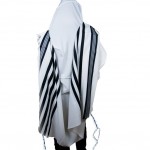First, let me tell you how not to size a tallit.
There’s a new yungerman in the neighborhood, who sits three rows ahead of me during Shacharit. He very badly wants to be pious. What bothers me about him is not that he prays loudly in a grating, whiny tone of voice, but his tallit. It’s too long.
A long tallit looks elegant to some, both because of its flowing length and because you have a lot of tallit spreading out across your shoulders. But the new congregant three rows in front of me every day got carried away. Although he pulls it forward a lot in front, it hangs down below the back of his knees in back, and the tzitzit are constantly sweeping the floor. And that what’s gets to me: Wearing a tallit is all about the mitzvah of tzitzit, and he’s showing a lack of respect for the tzitzit because of misguided notions of frum stylishness.
Tallit sizing: Get it right

Usually a size 55 is considered Small, size 60 is Medium, size 70 is Large. Some tallits comes in smaller sizes, i.e. 45 and 50, primarily for bar mitzvah boys, and some go all the up to size 80 or even 90. In most cases the sizes are in 10 cm/4 inch increments. That means if you have a size 60, for example, and are thinking of moving to a size 70, you can expect it to drape down 3-4 inches further in back (a bit of that extra length may come down in front, depending on how you wear it).
To figure out which size tallit you need you might want to dig out an old tallit, or borrow one and measure it, or you could go straight to our Tallit Size Wizard.
Some people wear a smaller, manageable size tallit on weekdays, and go one size larger for their Shabbos tallit.
Generally speaking, the length of the tallit (which, for clarifty’s sake, I prefer to refer to as the height) is usually considered the critical factor, but keep in mind that when you move up a size the tallit might be a bit wider as well, which means more tallit to bunch up on your shoulders.

